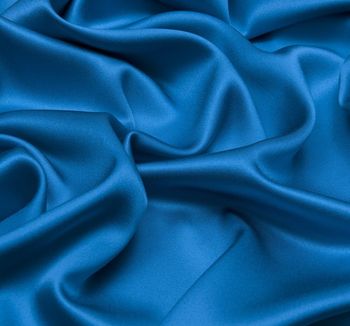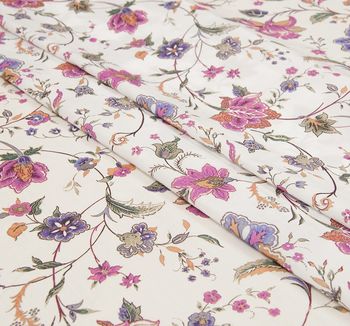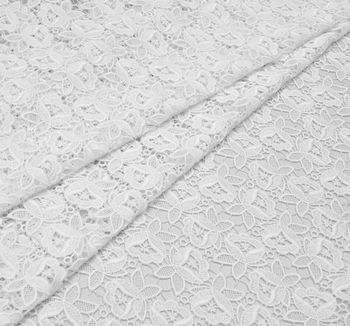Silk is a timelessly trendy natural fabric woven from the cocoons of silk worms. The world’s most famous fashion brands regularly apply it for various men’s and women’s outfits earning the admiration of the audience.
Jersey Fabrics
Jersey fabrics are single knit fabrics with a distinctive stretch. The name comes from the Isle of Jersey, one of the Channel Islands between Britain and France, where Jersey’s own sheep were bred. Back then, this soft material was made of wool, and the fabric was ‘for men only’. The most popular uses included underwear and fishermen’s sweaters.
In 1916, Coco Chanel introduced jersey to the fashion world. First, she created a heavy jersey coat, and then all kinds of jersey dresses that were extremely comfortable to wear. With her simple, yet elegant designs she popularized the fabric and made it available to women of all ages and builds.
Jersey materials are usually opaque, soft and drapey. They have fine ribs running lengthwise on the face side, and loops on the reverse. Plus, they are highly versatile! Jersey fabrics are easily sewn into dresses and skirts, tops and sweatshirts, cardigans and jackets, sweaters and trousers. You can also make shawls, scarves and other accessories.
Jersey fabric collection at Tissura
Types of Knit Fabrics
Let’s take one step back and look at the family of knit fabrics, since jersey is just one of the many kinds available now.
All knit fabrics are divided into weft knits and warp knits. The terms ‘warp’ and ‘weft’ show the direction in which these fabrics are created. In weft knits, a single yarn is looped to form horizontal rows, while in warp knits there are several yarns looped vertically.
Ready to go further? Here are some samples of knit fabrics:
Weft knits
- Rib knit
- Jersey knit
- Interlock knit
- Purl knit
Warp knits
- Raschel knit
- Milanese knit
- Tricot knit
In general, weft knits have more stretch. While both types of knit materials are naturally elastic, their ability to expand and bounce back increases a lot when you add elastane, lycra or spandex.
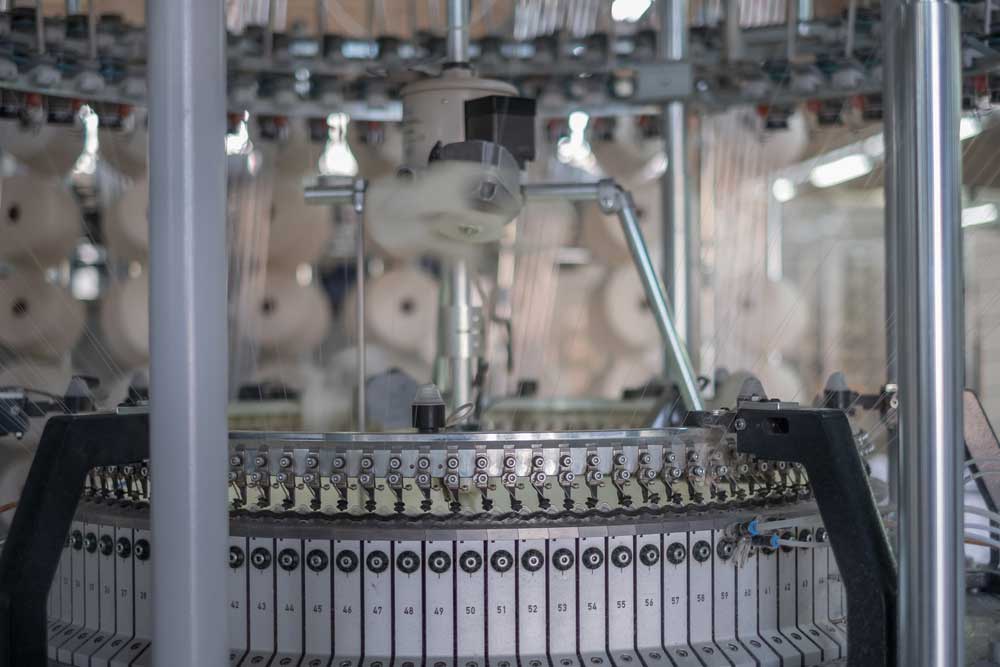
Jersey Fabric Characteristics
We’ve already mentioned that jersey fabrics were traditionally made of sheep’s wool. Today, you can find all sorts of jerseys: cotton, silk, hemp, bamboo, viscose, rayon, etc. There are even luxury knit fabrics woven of alpaca and vicuna! Such treasures require special care and cost a lot, but the pleasure of wearing them beats it all.
Jersey knit fabrics can be lightweight, medium-weight or heavy. They come in a variety of solid colors and prints. The weaving method makes them stretchy and comfortable in wear, so consider it a unisex material – it is a great wardrobe’s addition for men, women and kids alike.
So, what do we love jersey for?
Jersey fabrics are ideal for close-fitting and clingy items, and they do not hinder your movement unlike non-stretchy satin or silk taffeta fabrics. Jersey knits move with you!
- Elasticity
The degree of softness depends on the fibers your material is made of, as well as on the finish. To find a rough jersey fabric is a once-in-a-blue-moon occasion.
- Softness
This knit fabric is strong and resistant to tear.
- Durability
The very nature of this fabric makes it resistant to creases. Plus, it easily recovers its original shape after stretching.
- Wrinkle resistance
The thinner the fabric is, the easier the drape is. Fine, translucent jersey materials may have a tendency to curl at the edges, while heavier cloths are more stable.
- Drapability
Jersey knit is very adaptable. The range of applications varies from finest underwear and lightweight T-shirts to warm cardigans, rollnecks, winter dresses and sweaters.
- Versatility
Based on composition, jersey fabrics are divided into several types that have different texture, use and price. We are going to concentrate on natural fibers, because they are hypoallergenic and feel great to the touch.
Cotton Jersey Knits
Cotton jersey fabrics are made either of 100% cotton or cotton blend. They are soft, sturdy and opaque. Such knit fabrics are less drapable than, let’s say, silk or viscose jerseys, but they provide more structure to a garment. Plus, cotton is a breathable material which makes it one of the most widely used options for kidswear.
Nowadays, you can also buy stretch cotton jersey fabrics with spandex, lycra or elastane. These elastic fibers increase stretch and recovery factor, making such jerseys perfect both for tops and bottoms, including leggings, tights, and socks.
What can you make with cotton jersey?
- T-shirts
- Tank tops
- Blouses
- Dresses
- Skirts
- Pants
- Breeches
- Rollnecks
- Cardigans
- Jackets
- Leisurewear
- Sportswear
Rayon and cotton blend jersey fabrics have a softer hand and an easier drape. However, if you’re planning to make a pair of trousers, go with 100% cotton jersey knit, because it is more stable.

Silk Jersey Knits
Silk jersey fabrics are probably the smoothest and softest of all. These knits are fine and thin, very often translucent, with a beautiful silky sheen. Naturally elastic, they have even better stretch if produced with lycra or any other elastic fibers.
Silk jersey has a slinky drape, so no wonder fashion designers are in love with it! A very feminine type of knit fabric, it has literally dozens of uses.
- Tops
- Blouses
- Dresses
- Skirts
- Lingerie
- Tunics
- Wraps and cover-ups
- Leisurewear
Silk jersey fabric is more expensive than other knits, but sometimes it’s worth paying extra cash to get the best quality out there.
Silk is known for its ability to regulate body temperature, which means it’s cool to wear in summer and warm in winter.
Plus, silk jerseys look great in tucked and smocked designs. If you’re an ardent trend follower, you’ve probably seen them in many collections offered by renowned couturiers: yes, silk jersey can be haute couture!
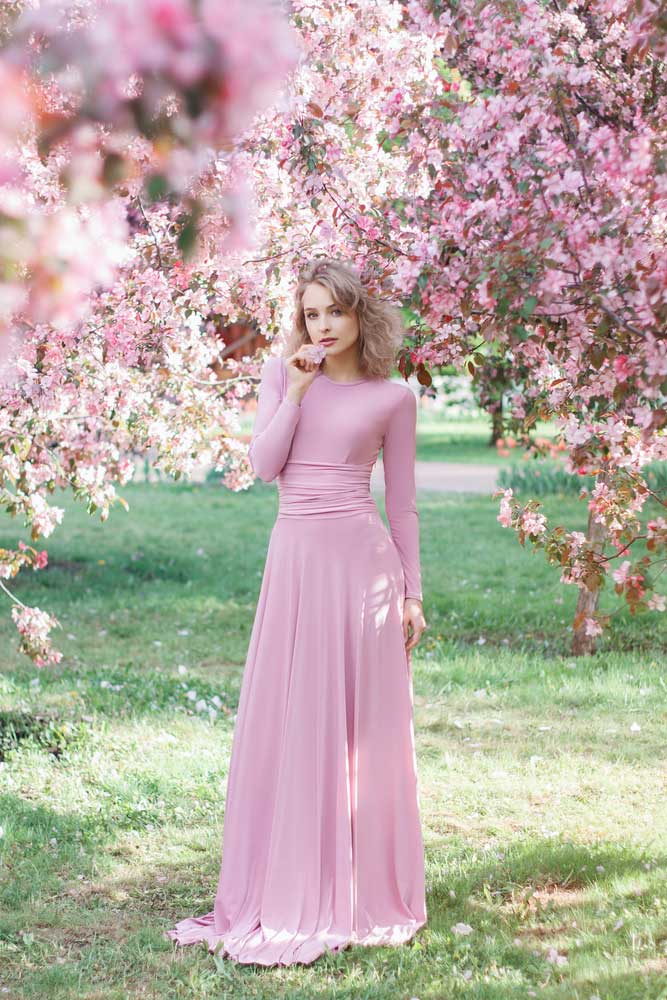
Wool Jersey Knits
Wool jersey fabrics are made either in pure wool or wool blends. They can be quite lightweight, but what you usually find in fabric shops is mid- to heavyweight wool knit fabrics. They are amazing for a number of reasons! First, wool is natural and warm, so anything made of wool is excellent for autumn and winter. Second, it is breathable and nice to the touch. Third, it is highly versatile. Think of all these wonderful ways you can use 100% wool jersey fabric!
- Tops
- Dresses
- Skirts
- Tunics
- Jackets
- Trousers
- Sweaters
- Cardigans
- Coats
- Ponchos
Wool knits are usually made of sheep’s wool such as merino or angora. However, today you can buy online even cashmere jersey! And while it might not be the most durable material in the world, it’s definitely a luxury fabric which can be used to create a one-of-a-kind sweater or tunic to wear on a special day.
Rayon Jersey Knits
Jersey knit fabrics made of rayon or viscose are characterized by a very soft and smooth finish. They are also very pliable and have an excellent drape. You’ll often find viscose and rayon knit materials with a touch of lycra, spandex of elastane. These will have even better stretch and recovery factor.
What are the best applications for rayon and viscose jersey fabrics?
- T-shirts
- Tunics
- Blouses
- Dresses
- Skirts
- Rollnecks
- Cardigans
- Sweatshirts
- Jackets
- Leisurewear
Double jerseys are usually less elastic and have more weight. They might not be the best choice for summer dresses, but they are definitely a go-to option for jackets and trousers.
Sewing with Jersey Knit Fabrics
There are several things one needs to consider before starting sewing. The knit fabric you end up buying should be suitable for the patterns you’ve chosen. Read on to check yourself and make sure you haven’t forgotten anything.
- Select weight and stretch.
If you’re planning to make a drapey top or dress, lightweight jersey fabric would be the best pick. Look for fine cotton, rayon or silk materials – they are soft, drapable and are ideal for gathered and smocked dresses. If you’re thinking about a warm jacket or a winter skirt, go for heavy or double knit cloth (wool would be perfect!). If you want to make a sweater or an oversize sweatshirt, pay attention to voluminous, textured fabrics, like soft rib knits or raschel.
Also make sure your jersey is elastic enough. Generally, such fabrics stretch both in the weft and in the warp, but heavier jersey types are usually 2-way. Elastane and spandex knits boast the greatest stretch factor, and that’s what makes them ideal for sportswear and clingy dresses.
- Select pattern or color.
Jersey knits are usually dyed or printed. Today, you can choose from hundreds of shades and tints available – fabric shops sell jersey of the prettiest colors like deep mint green, teal blue, or light mauve pink.
The number of prints is also unlimited. Floral jersey knits are one of the most popular patterns among women and girls, followed by paisley, animal, polka dot and intricate ornaments. You can also go with intarsia knit, which can be compared to jacquard fabrics. Intarsia means that the pattern you see on your jersey is woven with multicolored threads rather than printed.
- Prepare the fabric for sewing.
Professional tailors know how to treat jersey fabrics depending on their weight and content breakdown. If you’re just starting your sewist career, we recommend investing into quality literature to get answers to all your questions and concerns.
The basic procedure for pre-treating jersey includes steaming or dry-cleaning. Jersey fabric is prone to shrinking, so if you treat it before actually sewing, you won’t be disappointed in the future when you decide to wash or dry-clean your jersey shirt for the first time.
- Use correct needles and sewing machine.
The best machine to sew jersey is a serger, and the best needle is a ballpoint one. It is perfect for knit fabrics, because it does not tear holes in the cloth. We recommend using polyester all-purpose or Gutermann sew-all threads.
Here’s another jersey-related tip: reinforce stitching in the areas that will shift a lot. Pay attention to neckline, shoulders, buttonholes, collar, flap pockets. You can use fusible knitted interfacing.
- Know how to care for your jersey.
Care recommendations vary a lot depending on the content, so make sure you know what your jersey fabric is made of. If your knit material is ok with ironing, avoid pressing it firmly and moving the iron back and forth. Instead, press it gently, then lift off the iron and press it again in another area. Let your jersey garment cool before putting it on, or you’ll risk damaging it.
What to Make with Jersey Fabric?
Remember, once jersey was a men’s fabric only? Coco Chanel made it an essential part of women’s wardrobe. She created loose blouses, tops and cardigans using cotton and wool jersey. Coco believed that every woman should be able to bend down to put on her shoes, and jersey was the perfect fabric because it allowed for a lot of movement. In 1924, she made comfortable clingy jersey costumes for the ballet dancers from “Le Train Bleu”. That was indeed a revolution!
Ok, now back to the question. What can you make with jersey fabric?
- Wrap dresses
- Maxi, midi or mini dresses with batwing style, raglan or capped sleeves
- Panelled bodice dresses
- Peasant dresses
- Knit tops, such as halter back or tank tops
- Polo shirts
- Full or pencil skirts
- Jackets with front lapels – or without
- Tunics with ruffle hems
- Wide-leg, side-zip trousers
- Capri leggings
- Robes and pyjamas
- Kids’ summer dresses and breeches
- Hosiery
- Underwear
- Sportswear
- Sweaters and cardigans
With jersey, we could go on forever. But we’ll give you the freedom to come up with your own ideas. Meanwhile, let’s think about other possible uses for jersey knit:
- Headbands
- Appliques, e.g. flowers
- Scarves
- Wraps (baby wraps included!)
- Pillow covers and slipcovers
- Quilts
In general, jersey garments have a simpler cut compared to items made of woven fabrics. Since jersey knit is stretchy, you do not need buttons, zippers or closures to make a dress or a shirt – it can be pulled on over the head. Plus, jersey fits all kinds of body sizes and shapes. Probably, the best news ever!
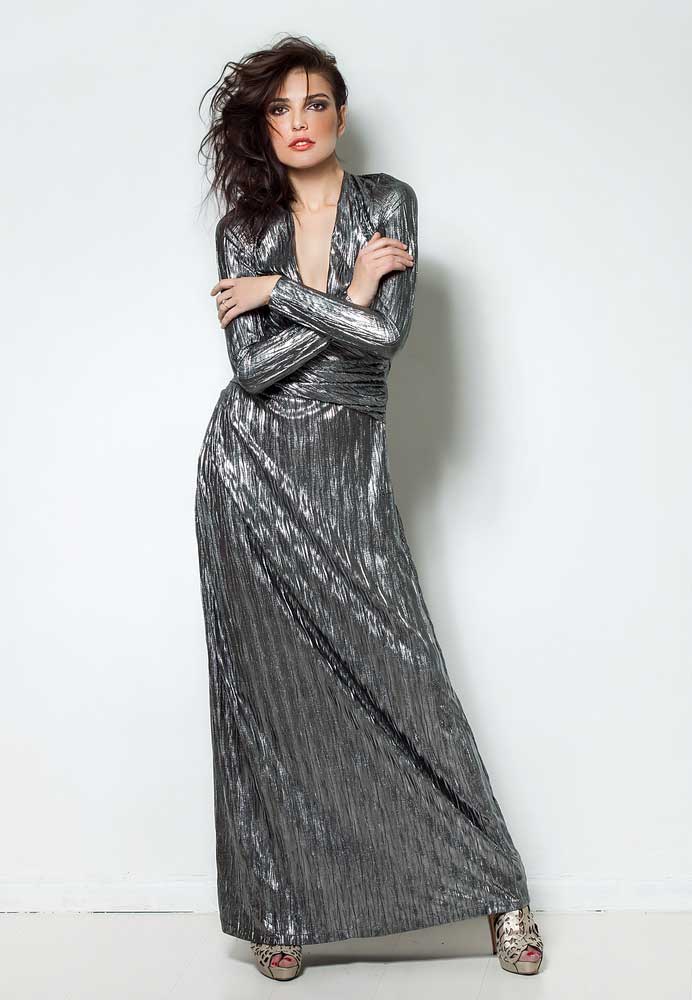
Jersey Fabric in Fashion
Jersey is the kind of material that needs no advertising. Everybody knows that it’s comfortable, wrinkle-resistant and stretchy.
Usually jersey makes its way into the world of fashion when winter is around the corner. Then we get to see lots of tops, cardigans, sweaters and dresses created with insulating materials. Lightweight jersey fabrics can be worn in spring/summer too, and some designers even offer evening dresses and gowns made of draped jersey.
Tailored jackets, pants and sweatshirts are also among the most common jersey garments. Plus, this soft fabric looks great with different textures, like fur, leather or even silk! You can keep the look simple, avoiding extra accessories, or – quite on the contrary – create a dress with printed or embroidered jersey knit.
The Jersey Selection at Tissura
The range of solid and printed jersey fabrics you can buy online at Tissura Fabric Shop consists of high quality knits delivered from:
- France
- Great Britain
- Italy
- Switzerland
Tissura offers the most fashionable colours and prints of various quality: 100% silk, viscose, wool and cotton, stretch jersey fabrics, silk and cashmere, and much more.
Plain jersey knit is perfect both for casual and formal wear. From dresses and skirts to jackets, pants and even accessories, this fabric is easy to pair with almost any solid or printed material.
Patterned jersey fabrics are ideal for year-round wardrobe essentials. The range of prints includes floral, geometric, abstract, ornamental, dotted, striped and animal knits.
Wool jersey knit fabric, 50 € (53 US$) per one running metre;
Knitted fabric, 38 € (46 US$) per one running metre;
Stretch jersey knit fabric, 59 € (71 US$) per one running metre;
Stretch jersey knit fabric, 90 € (108 US$) per one running metre
How to stay cool on a hot summer day? Wear fabrics built for the heat. Cotton, linen, viscose, silk – there are dozens of summer-friendly materials you can choose for your wardrobe. The best fabric to opt for when the temperature rises should be breathable and comfortable.
The wedding dress is one of the most important clothing items a woman gets to choose in her lifetime. It can be made of silk or cotton, lace or tulle, be strewn with sequins or embroidered with beads.
.jpg)
.jpg)
.jpg)
.jpg)
